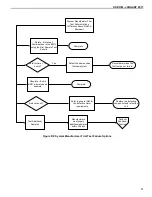
USE OM - JANUARY 2017
39
APPENDIX F
– SETUP, COMMISSIONING AND OPERATING CHECKLIST FOR LABORATORY PERSONNEL
Setup Checklist and Operating Procedures for the Laboratory Personnel:
1.
Verify that the nameplate model is the same as the AHRI requested model.
a.
Check if there are additional comments in the data.
2.
Follow the manufacturer’s installation instructions and related drawings (manufacturer representative may be
present).
a.
Charging instructions.
i.
For heat pumps, determine the IRV of the test coil from the Directory. Follow the System
Manufacturer’s charging instructions for a coil (whether ICM or a different System Manufacturer
coil) with the closest IRV. If no instructions are available, consult the coil manufacturer for specific
charging instructions.
b.
Tubing sizing.
c.
Airflow tap settings.
d.
Expansion device. If there is a use of a TXV, ensure there is insulation on the bulb. Check that the bulb
is attached and positioned correctly.
e.
Verify all enhancements per the rating are installed properly (e.g. demand defrost board, liquid line
solenoid, TXV, time delay relay).
f.
Note
any deviation from the Participant’s published installation instructions.
g.
Verify that the unit is physically installed per the installation instructions.
3.
Verify the ductwork meets ASHRAE 37 requirements.
4.
Inspect indoor ductwork for leaks.
5.
Verify that the indoor coil is sitting in the housing and is positioned correctly.
6.
Inspect the trap for condensate is clear of obstructions and check if the condensate is leaving.
7.
Verify that the correct nozzles are selected for the given airflow range.
8.
Verify that the voltage to be applied matches the voltage listed on nameplate.
9.
Verify major components are of compatible voltage.
10.
Compare the indoor fan watts against known values (if available).
11.
Verify installation to the manufacturer’s supplemental checklist (if available). (AHRI shall approve)
12.
Verify the refrigerant line length between Outdoor and Indoor Units against the
manufacturer’s published
installation instructions.
13.
Verify airflow rates of Indoor Units.
Additional Procedures and Checks Following a Failure:
1.
For high stage and low stage compressor operation:
a.
Indoor (ID) airflow;
b.
ID watts;
c.
ID static;
d.
Outdoor (OD) airflow if OD air is the secondary check or refrigerant mass flow;
e.
OD watts on fan motor;
f.
Compressor watts;
g.
Sub-cooling and superheat; and
h.
Liquid temperature.
2.
Record the temperatures leaving the circuits.
3.
Photos of test setup.
4.
ID airflow speed tap. List all speed tap changes.
5.
Time between defrost.
6.
Report any error messages or abnormally flashing lights.
7.
Last date that the LEAP (Appendix H) was conducted.
















































